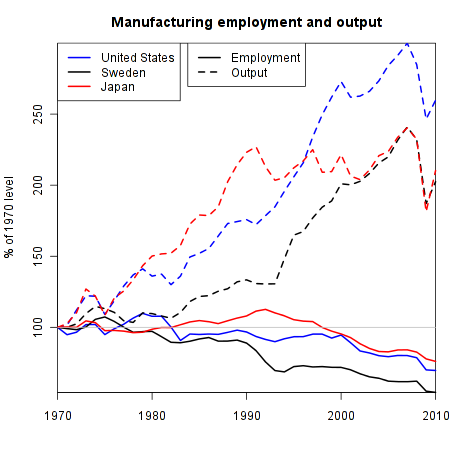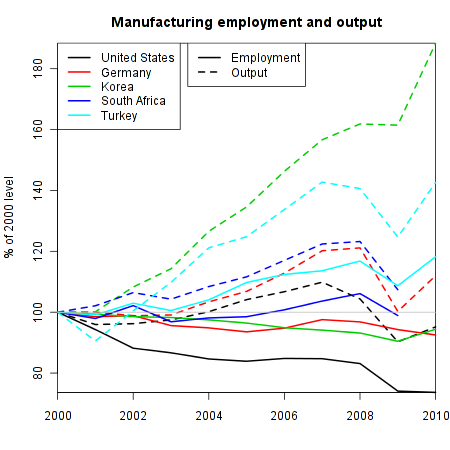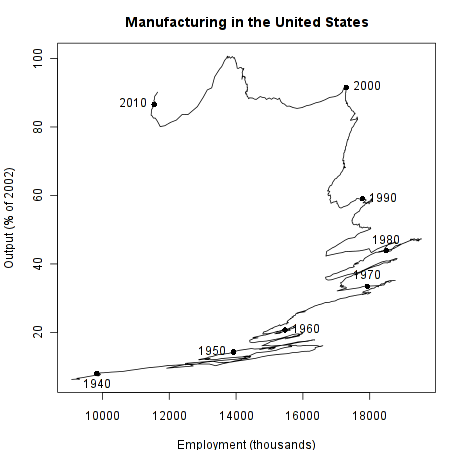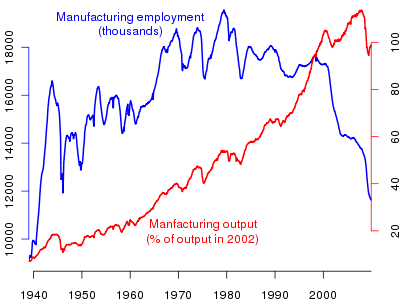Critics of neoliberalism, from right and left, have often remarked on the nonsensical quality of Gross Domestic Product as a measure of societal wealth. Since GDP measures everything which is paid for on the market, it cannot distinguish between positive and negative forms of economic activity. A cure for cancer becomes equivalent to cleaning up an oil spill, so long as both cost money. On the other hand, helping your neighbor carry her groceries up the stairs has no economic value, while the production of cigarettes and the treatment of lung cancer become major sources of "wealth".
This critique is really two critiques, however, one of which has some radical implications. Merely pointing out that GDP valorizes things like environmental destruction and weaponry as forms of wealth leads to a tame (if salutary) reformism: such "public bads" should be taken off the books, or counted negatively against those good things which are produced for sale in the market. All this amounts only to a better accounting method, a better way of showing how much, and how efficiently, is being produced by the capitalist economy.
But the critique of GDP points to a deeper question: why should things be produced for money at all, regardless of whether they are good or bad? That is, do we really gain as a society when things which could be performed voluntarily and for free become paid jobs?
The standard response to this question is that, while it would certainly be nice if all production could be undertaken voluntarily rather than under the discipline of wage labor, such an anarchist utopia is totally impractical. And for many goods, this is a real and difficult problem. The same things that make production efficient--the division of labor, repetitive and tedious jobs--are the same things that make people not want to do them unless they get paid. To address this problem, we need some way of negotiating the trade-off between having more things and having more (and higher quality) free time. Of course, under the present fetishization of constant economic growth, it is impossible even to articulate such a trade-off, except in the language of consumer or worker "choice".
But let us set this set of problems aside for a moment. The tension described above is true primarily for physical goods, things like cars and shoes. But what is distinctive about the capitalism that has developed over the past few decades is the increasing preponderance, in the money economy, of commodities that are not physical objects, but intellectual property of one kind or another. Let us take a single example, from the computer software industry.
Microsoft is preparing to release the new version of Microsoft Windows, called "Vista". In the run-up to launch, the company is making every effort to persuade customers of the value of this new product. One of the most important targets of persuasian has been the European Union, which has been increasingly unhappy with Microsoft's monopoly business practices. To the end of persuading the EU to welcome Vista with open arms, Microsoft recently released this white paper. Its purpose is to outline the positive economic benefits which Microsoft Vista will supposedly bring to Europe. These, are, according to Microsoft:
- Within its first year of shipment, IDC expects Windows Vista to be installed onmmore than 100 million computers worldwide. More than 30 million computers inmthe region studied are expected to be running Windows Vista.
- In the six countries studied, Windows Vista-related employment will reach moremthan 20% of IT employment2 in its first year of shipment.
- While much of this employment will shift from Windows XP-related employment,mover 50% of the growth in IT employment will be driven by Windows Vista.
- For every euro of Microsoft revenue from Windows Vista in 2007 in the sixcountries studied, the ecosystem beyond Microsoft will reap almost 14 euro in revenues. In 2007 this ecosystem should sell over ?32 billion ($40 billion) in products and services revolving around Windows Vista.
- Within the six-country region, in 2007 over 150,000 IT companies that produce, sell, or distribute products or services running on Windows Vista will employ over 400,000 people; another 650,000 will be employed at IT using firms.
Billions of dollars in economic growth due to Vista! What wonderful news! But wait--what does this mean? One critic quickly saw through the gambit on offer:
The white paper may predict sales by the "Microsoft ecosystem" of over $40 billion in six of Europe's biggest economies, but what this figure hides is the fact that income for Microsoft and its chums is a cost for the rest of Europe. In other words, IDC's white paper is effectively touting an expense of over $40 billion as a reason why the European Commission should welcome Vista with open arms.As the paper itself mentions, half of this cost is down to the hardware. Some of these purchases would have taken place anyway; the rest represent upgrades from older hardware that cannot meet Vista's requirements. But if Vista did not exist (or, for example, if the European Commission were to block its sale for whatever reason), the old systems would not suddenly stop working: they would tick along for a few more years, gradually being replaced. The only justification for this hefty expenditure is to be able to run Vista: no Vista, no need to rustle up many extra billions on hardware upgrades outside the usual replacement cycles.
It's the same on the software side. The case for Vista itself is hardly strong. As the product's ship date has slipped, so more of its new features have been ripped out. Now it is not entirely clear what the benefit of upgrading is (apart from the evergreen "better security", of course). And without the need for hardware and software upgrades, the associated consultancy and service costs disappear too: most of Vista's $40 billion "benefit" is not only a cost, but an unnecessary one at that.
A product which imposes heavy costs on users, including accelerated hardware obsolesence, without clear benefits? Who would want such a thing? The economic growth being cited by Microsoft is evidently the kind of phony "wealth creation" cited by critics of GDP in the first sense mentioned above. But we can also ask the second question. Suppose that Vista did have discernible benefits. Certainly operating systems, generally, are useful things, and have to be upgraded sometimes. Even if Vista was a better piece of software, we might still ask: why should such a thing be made by a private company and sold for a profit? Why couldn't people just make it for free in their spare time, and then give it away?
To which Microsoft might respond: without the possibility of profit, there would be no incentive to innovate, and hence no-one would write operating systems. As against the cases of shoes and cars, however, a clear counterexample exists that vitiates this argument. The existence of free and open-source software is an excellent example of a post-capitalist form of production, in which social wealth is produced outside the system of economic (monetary) value.
The fact that the things like software can
be produced for free in the "social economy" does not mean that everything can be produced this way, as some of the more exuberant proponents of the "immaterial labor" thesis would have you believe. Yet by criticizing the facile equivalency between economic activity and wealth, we can begin to move toward a real critique of capitalism. This critique, if it is to reinvigorate socialism as an idea, has to take as its starting point this observation of Marx's, from volume 3 of Capital, one of the few places where he prefigures the communist future:
The actual wealth of society, and the possibility of constantly expanding its reproduction process, therefore, do not depend upon the duration of surplus-labour, but upon its productivity and the more or less copious conditions of production under which it is performed. In fact, the realm of freedom actually begins only where labour which is determined by necessity and mundane considerations ceases; thus in the very nature of things it lies beyond the sphere of actual material production. Just as the savage must wrestle with Nature to satisfy his wants, to maintain and reproduce life, so must civilised man, and he must do so in all social formations and under all possible modes of production. With his development this realm of physical necessity expands as a result of his wants; but, at the same time, the forces of production which satisfy these wants also increase. Freedom in this field can only consist in socialised man, the associated producers, rationally regulating their interchange with Nature, bringing it under their common control, instead of being ruled by it as by the blind forces of Nature; and achieving this with the least expenditure of energy and under conditions most favourable to, and worthy of, their human nature. But it nonetheless still remains a realm of necessity. Beyond it begins that development of human energy which is an end in itself, the true realm of freedom, which, however, can blossom forth only with this realm of necessity as its basis. The shortening of the working-day is its basic prerequisite.
Now the distinction between "freedom" and "necessity" is not as clear-cut as Marx seems to imply here, and it is not coextensive with "immaterial" and "material" goods. Fine wines and Sony Playstations are material goods, but are they necessary ones? This is, ultimately, a political question, but it is not one that can be resolved in capitalism. Defining the boundary between the realm of necessity and the realm of freedom is, I would argue, the specific content of socialism as a form of society and a political process (rather than a telos, a utopia, or an end of all politics). Framing things this way explodes the false opposition between state planning and market anarchy. The aim of socialism is not to pull all economic activity under the control of the state. Rather, it is to push out as much as possible from commodity production in the market to socialized labor in the "free" sector.* Conversely, only where necessary, that is, where other ways of organizing production are not feasible, would production be pulled in to collective control by the state, workers collectives, or some other communal form.
This formulation opens a new horizon of possibility for the socialist project, a new vision of what society could be like. It also clearly rules out certain longtime "left" preoccupations as being basically anti-socialist. The Keynesian idea that we need more jobs and higher wages for everyone comes to seem dilatory, in this view: what we need instead are shorter hours and a lower cost of living. As a corollary, we need things like socialized health care and child care, which reduce individual dependence on wage-labor. Neither of these are anti-capitalist programs in themselves; yet they point away from capitalism rather, as with Keynesianism, toward an intensification of its logic.
Left untheorized, here, is imperialism, or more generally, uneven development (and by implication, racism). If too much wage-labor is the constitutive problem of European and North American societies, this cannot be said of much of the rest of the world--or even of the pockets of deprivation within the rich societies. Thus, the socialist project must entail a massive, internationalist, redistributive project along with the anti-capitalist project delineated here, if it is not to degenerate into the construction of elite islands of privilege in a global sea of misery. (In this, Hardt and Negri are right: a guaranteed income and global citizenship are the sine qua non of the left project today. Unfortunately, their naive postmodernism and reflexive anti-statism made them unable to connect this realization with a coherent political strategy.) Likewise, ecology and the reality of physical limits on human societies demand serious attention, if we are to give real content to Marx's comment about "the associated producers, rationally regulating their interchange with Nature". And last but not least, what is described here is intrinsically also a feminist project: without a critique of unpaid women's labor, reduction of paid labor just reduces itself to a patriarchal ideology of the "family wage". But consideration of these dilemmas will have to wait for another time.
[* The free sector, or the realm of freedom, would be free in a double sense: its products would be available to everyone for free, like open source software; at the same time, the laborers themselves would be "free" in the sense that they work according to their own schedules and according to their own desires, rather than at the direction of a boss. The realm of freedom is thus, pace Stallman, free as in free spech, and free as in free beer.]





